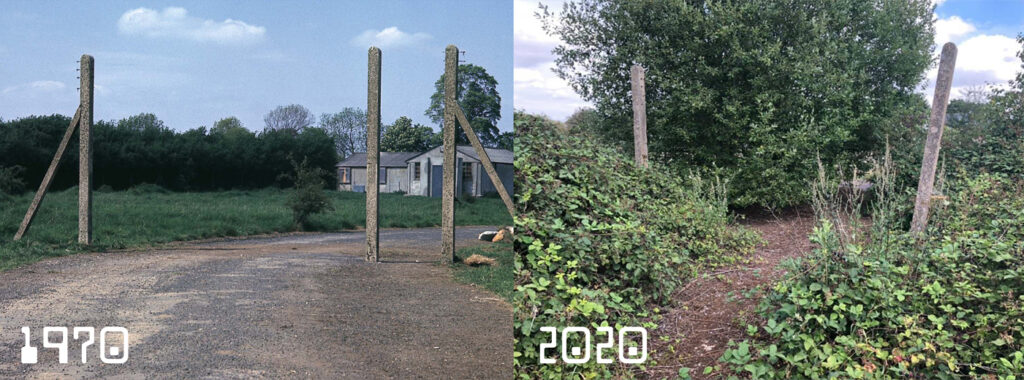Finding the Time Barrier
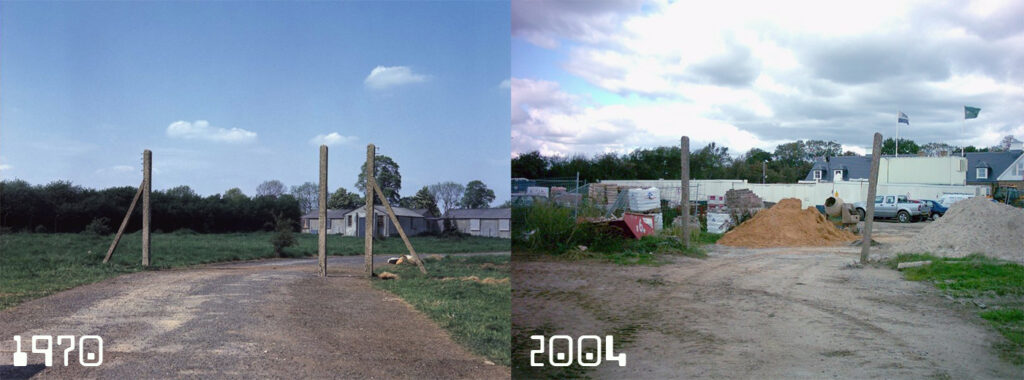
Without a doubt the location of the time barrier in Timeslip is one of the most enduring images of the series. The decaying edifice of the derelict St. Oswald Naval Station’s concrete prefabs, the windswept and bleak Ministry field and the iconic fence posts, shorn of their wire, redundantly standing amongst the scrubby vegetation and cracked concrete give a unique feel to the series. It’s the initial link to the past in The Wrong End of Time and the place where all the loose ends come together at the climax of Day of the Clone.
Asking people who remember the series what comes immediately to mind when they think of Timeslip, they usually reply; “That’s the one where the kids go through the hole in the fence, isn’t it?” So where was St. Oswalds in real life?
In researching the location of the Ministry field I had many false leads and generally vague information. My first stop was to put out an appeal via the pages of the magazine TV Zone (via their Memory Alpha page). The best they could come up with was that it was “Somewhere in Herefordshire” – Not very helpful and, as I wasn’t to discover until many years later, totally wrong!
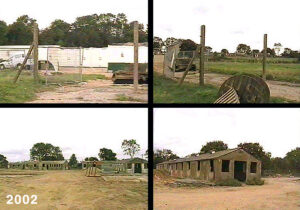 I consulted maps of Herefordshire looking for old military establishments (I was pretty sure that the location was a GENUINE military base of some sort.) but found nothing I could really say was significant. Sadly, the trail went cold at that point and I moved on to other projects.
I consulted maps of Herefordshire looking for old military establishments (I was pretty sure that the location was a GENUINE military base of some sort.) but found nothing I could really say was significant. Sadly, the trail went cold at that point and I moved on to other projects.
I wasn’t until the spring of 2002 that I had a proper break in my search. By this time I had become a professional (if not successful) writer and I had occasion to meet and have lunch with the wonderful Victor Pemberton. The meeting was to discuss a completely unconnected matter (in fact his work on Doctor Who) but I simply couldn’t miss the opportunity to ask him about Timeslip. Victor, of course, wrote Day of the Clone as well as holding the rights to the series in the early nineties when a sequel was being discussed.
I knew Victor to be a very ‘hands-on’ writer who liked to see his work coming to life in front of the cameras, so I asked him if he’d attended any of the location shoots during his tenure on Timeslip… and he HAD! Bingo!
Victor told me that the location work had been done just outside of a village called Cuffley, which was located about ten miles from the former ATV studios in Elstree. He said he couldn’t remember EXACTLY where the location was, but he did remember it was near a school. We both agreed that it was unlikely that the buildings would still be there. They appeared to be derelict when the series was made thirty-two years previously. I said it would be nice to visit the site anyway.
As soon as I got home I went to work with my road atlas. I looked up Cuffley and found it to be in Hertfordshire (NOT Herefordshire) and indeed it was located fairly close to Elstree.
Due to various circumstances I was unable to visit Cuffley for several months after my meeting with Victor, but eventually the opportunity arose and I was able to pass through the village on my return from a business meeting in London.
Accompanying me on the trip was my good friend and fellow Timeslip buff, Andy Thompson who was going to act as an extra pair of eyes for me on the expedition.
As we drove into the village it occurred to me that we didn’t really have a lot to go on. All we had was a general location and a nearby school. We thought of trying the village library but by one of those twists of fate that seem to dog us all from time-to-time, it was closed on this particular day.
I thought of trying to find a local newsagent to see if they had a map of the local area, or better still, a member of staff who might recall a local military establishment and might have an idea where it had once stood.
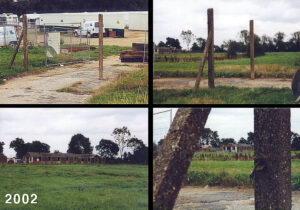 Although we looked we found no such place or person and so we resorted to getting back in the car and simply scouring the neighbouring countryside for any likely looking locations. The mission was fruitless and so we made our way back to the village and rethought our strategy. It was then I spotted the estate agents. If anyone would know the local area in detail it would be an estate agent.
Although we looked we found no such place or person and so we resorted to getting back in the car and simply scouring the neighbouring countryside for any likely looking locations. The mission was fruitless and so we made our way back to the village and rethought our strategy. It was then I spotted the estate agents. If anyone would know the local area in detail it would be an estate agent.
There were actually two such establishments in the village and at the first one we visited we drew a definite and resounding blank – they hadn’t the foggiest idea what we were talking about. I was getting seriously worried that we would be returning to Derby disappointed and frustrated, having got to within perhaps a few hundred yards of our goal. With trepidation I entered the second agency and asked if anyone knew of the site of an old military base in the area. My request was met with blank looks until one of the ladies in the office suggested asking the agency owner. He was called into the office and I once again trotted out my description.
To my amazement he not only told me then he knew exactly what I was talking about and where I could find it, but he told me that the place was still standing… at least for the moment.
The last piece of news came as a shock. Apparently the whole site was about to be redeveloped for housing and the existing buildings were to be bulldozed! Another fact the agency owner had given us explained why we couldn’t find the place in the surrounding countryside. It turned out the camp was located on the outskirts of the neighbouring village, Goff’s Oak and not in Cuffley. He told us in order to find the camp, we should drive up the hill into Goff’s Oak, turn right onto Jones Road, drive to the very end and turn left into Silver Street.
Excited that we might finally be getting somewhere and given another boost by the knowledge that the buildings were still standing, Andy and I climbed back into the car and made our way to Goff’s Oak.
We motored up the hill, turned right into Jones Road as instructed and it was as we neared the barred gate that marked the end of the road that Andy tapped my arm and pointed to the left: we were passing a school. The pieces were all beginning to fit.
At the end of Jones Road we turned left into Silver Street (something of a misnomer as it is in fact a country lane) and we immediately noticed a large board fence to our right – the sort of thing that always surrounds building sites – and through a pair of open gates were the decaying concrete prefabs we sought!
At once we were both delighted and deflated. We had most definitely found what we were looking for but the churned up ground and heavy plant passing to and fro on the site, obviously meaning business, lent a sense of doom to the whole mission.
We drove on down Silver Street to see it we could find a vantage point to see more of the camp – either high ground or a larger gap in the fence (ironic isn’t it? Us looking for holes in fences!) but although the fence didn’t extend all the way round the camp, it was surrounded by trees and, given it was August, they were at their most thick and luxuriant!
So, if we wanted a proper look, we only had one option…
We drove onto the site feeling more than a little self-conscious. The first thing that struck us about the camp was its size. It was much bigger than it appeared in Timeslip and there were many, many more buildings than appeared in any shot in the series. We decamped from the car and I went in search of the site manager. A worker who was busy near the entrance quickly showed me to the site office Portakabin and it was just outside there that I made my most interesting and important discovery. Just beyond office, about 30 metres away, were the fence posts… or at least two out of the three original sets.
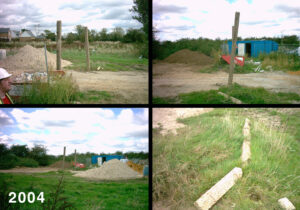 The site manager came out to meet me and I explained that I was researching a series that had been filmed there some thirty years ago and could I get some photographs of the area before it was changed beyond recognition? The manager politely declined and I was reduced to greedily staring at the fence posts over his shoulder and trying to concentrate on what he was saying. But suddenly he regained my attention.
The site manager came out to meet me and I explained that I was researching a series that had been filmed there some thirty years ago and could I get some photographs of the area before it was changed beyond recognition? The manager politely declined and I was reduced to greedily staring at the fence posts over his shoulder and trying to concentrate on what he was saying. But suddenly he regained my attention.
Apparently the camp was indeed going to be redeveloped for housing but many of the buildings were to remain standing and be converted into bungalows! Further more, the site manager told me that if I got permission from the site owners, I WOULD be allowed on site to take my photographs. I thanked him very much and made my way back to the car. Now I knew where the place was and I had a chance to record it on film at a later date. Andy I and drove back to Derby already planning our next move…
The very next day I was on the internet looking for the property developer’s website. With this located I was able to send an email to ‘whom it may concern’ with the details of my request. Days passed and became weeks with no reply or even an acknowledgement. I was getting decidedly worried, especially given the earnest way in which the site workers had be going at their work. Would there be anything left to see by the time we got onto the site?
Finally, I decided to just try and phone the head office and work it from there. After being forwarded to several different offices and departments in various corners of the country, I was able to speak to no less than the managing director’s secretary who promised she would get someone to call me back.
The next day the phone rang; it was the managing director no less! I explained what I wanted to do and he couldn’t have been more helpful! I was granted permission to go on-site and to take photographic and video equipment, too!
Within a week I had arranged with Andy to revisit the site and, armed with various cameras, we made our way back to Goff’s Oak.
This time when we arrived on-site we were expected and even made welcome! Kitted out with high-visibility vests and hard hats, Andy I made our way around the camp photographing and videoing all we could remember from the programme. Some of the building had been demolished (for instance, the smaller block that sticks out at right angles from the long block which is seen in most of the location work is no longer there).
Of course, the focus of our visit was the fence posts that marked the entrance to the time barrier. As is stated earlier, two of the three posts remain standing with the third, along with its bracing piece, lying in the grass where it fell. In real life the posts marked the entrance to the rear of the camp and guarded a short road that led to the anti-aircraft gun emplacement behind the camp. Passing through those hallowed posts we explored the area that is better known to ‘slippers’ as the Ministry Field.
The place is honeycombed with various bunkers and shelters that surround the huge, central ack-ack emplacement.
The ‘vibe’ of the place was VERY strange – almost unearthly in its quiet. Despite the heavy machinery working nearby, it was easy to get in amongst the concrete blockhouses and be in an almost deathly silence, with just the wind blowing through the grass that is now rampant throughout the whole area. The effect was enhanced by the fact that the place is largely unchanged since the programme was made. This was later reinforced by the cast and crew who saw the video footage we shot. One could imagine that shooting on the series had only finished the week before. It is ironically fitting that time has almost stood still there.
When we had photographed and videoed all we could, we left the site in the sad knowledge that the next time we saw it, it would be a very different place.
However, as an interesting footnote, it turns out that the land that forms the ‘Ministry Field’ – fence posts included – isn’t owned by the developers who own the buildings but by a third party and that it’s also protected by National Heritage…
Perhaps the ‘Ministry Field’ will continue to be a bubble of frozen time!
Steve Hardy
(2002/2004 Photos by Steve Hardy. 2020 photo by Nick Halling.)
